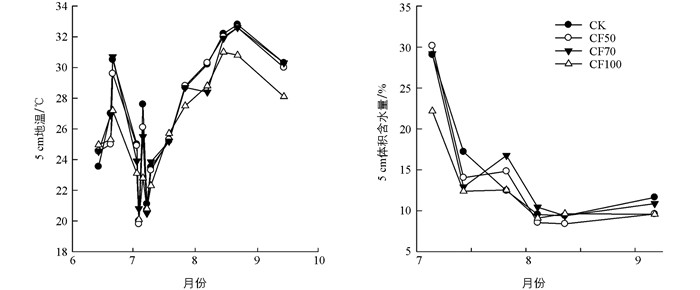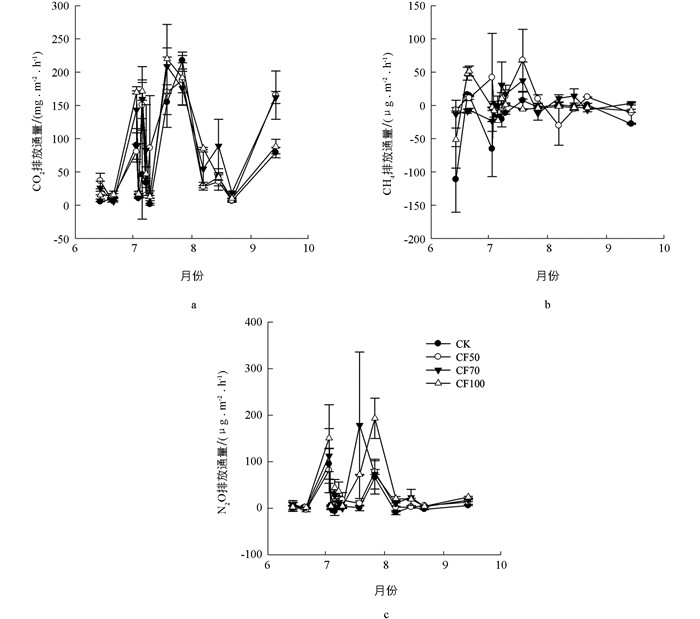-
开放科学(资源服务)标志码(OSID):

-
在农业生产中,人们大量使用氮肥以提高作物产量. 近年来,中国农业生产中的化肥投入量增长十分迅速,高强度的化肥施用给生态和环境带来了显著的负面影响. 农田中的氮、磷随地表径流进入受纳水体,或随地下水渗入土壤,引起农业面源性富营养化,土壤污染、面源污染严重[1]. 氮肥对增产有显著作用,但也会影响CH4,CO2和N2O等农田温室气体排放. CH4,CO2和N2O是导致全球变暖的3种主要温室气体,而旱地农田土壤是CO2和N2O的主要排放源,其温室效应不容忽视[2]. 玉米作为我国最大的粮食作物,在缓解饲料短缺、保障粮食安全方面发挥着重要作用[3]. 因此,探究不同施氮量对温室气体排放特征和作物产量的影响,确定合理的施氮量,对提高作物产量、减少农业温室气体排放具有重要的实际应用价值.
种植模式[4]、施肥方式[5]等会影响作物产量,而氮肥是影响鲜食玉米产量和品质的重要因素之一[6]. 大量田间实验表明,增加氮肥施用量可提高作物产量[4, 7],但大量施用化肥会产生过多的温室气体[8]. Qiu等[9]研究指出在旱地生态系统中,施氮显著增加了土壤N2O和CO2排放;Shcherbak等[10]发现随着施氮量的增加,N2O排放量会呈指数型增加. 也有研究发现,在稻麦系统中,当施氮量从270 kg/hm2降低到190 kg/hm2时,N2O累积排放量将减少26.0%~34.4%. 高氮肥施加量可增强植物光合作用,刺激根系微生物,土壤呼吸增强,导致较高CO2排放量[11]. 适宜施氮量可促进青贮玉米干物质积累和水分高效利用,保证玉米根际养分的有效供给,营造良好的根际土壤环境,提高氮素利用效率,提高玉米籽粒产量[7],表明合理施氮对温室气体排放及玉米产量有极其重要意义. 以往的研究重点多在于玉米地N2O和CO2气体的排放[8, 9, 12],尽管旱地系统不是CH4排放的重要来源,但是探究氮肥用量对玉米地CH4通量的定量作用,对于明确氮肥对玉米生态系统综合温室效应的影响具有一定的指导意义.
黄壤是西南地区主要土壤类型之一,主要分布于贵州、四川、云南等省. 贵州黄壤面积超过700万hm2,约占全国黄土总面积的30%,其中旱耕地约460万hm2,占全国旱耕地面积的46%左右[13]. 贵州属喀斯特山区,降雨分布不均,且土壤质地较粘,酸性强,土壤交换性碱质量分数低. 虽然黄土表层有机质质量分数较高,但土壤氮素转化淋溶现象尤为突出,导致黄土氮库明显不足[13]. 氮肥增产的同时增加了温室气体排放,因此如何提高黄壤土氮肥有效性,实现玉米增产稳产、温室气体减排是亟待解决的重要问题. 本研究在贵州黄壤地开展大田试验,分析不同氮肥施用量对玉米产量以及贵州黄壤土温室气体排放的影响,旨在为旱地黄壤土合理施肥,玉米增产稳产,温室气体减排提供理论依据.
全文HTML
-
试验地位于贵州省贵阳市花溪区麦坪乡(东经106°27′-106°52′,北纬26°11′-26°34′),海拔1 100 m,属亚热带湿润季风气候. 年平均气温16.0 ℃,其中冬季平均气温7.0 ℃,夏季平均气温23.7 ℃,全年无霜期246 d,年降水量1 178.3mm,降水分布不均,4-8月降水量占全年的70%. 该地处于云贵高原东斜坡和苗岭山脉中段,全区地貌以山地和丘陵为主,为典型的喀斯特地质地区,土壤类型为黄壤. 土壤pH值为5.62,有机质质量分数为39.18 g/kg,碱解氮为178.10 mg/kg,速效磷为8.96 mg/kg,速效钾为183.67 mg/kg.
-
试验设置固定氮肥梯度试验样地,根据当地施肥量设置了4个氮肥施肥梯度,分别为不施肥(CK:对照)、减量50%氮肥(CF50)、减量30%氮肥(CF70)、传统施肥(CF100),试验小区面积为18 m2,每个处理3个重复,完全随机排列. 当地传统化肥施用量为N 273 kg/hm2和P2O5 264 kg/hm2. 试验所用肥料为尿素(含N 46%)和磷酸一铵(含N 11%,P2O5 44%). 磷酸一铵用作基肥,在玉米播种前一天施入,其中包含总施氮量的25%;尿素分两次追加施入,其中第一次追肥施氮30%,第二次追肥施氮45%. 本次试验供试玉米品种为安单3号,于2019年4月9日播种,行距、株距均为60 cm,2019年5月12日(拔节初期)第一次追肥,2019年7月3日(抽雄吐丝期)第二次追肥,2019年9月14日收获,其他田间管理措施与当地常规田间生产一致.
-
植物样采集:在玉米收获期,每小区随机取10株玉米,65 ℃烘至恒质量,测定其籽粒产量以及秸秆生物量.
土壤样采集:供试土样于玉米收获时采集. 各小区按5点采样法,采样深度0~20 cm,充分混合后,挑取植物残根和碎石,风干、磨碎过筛. 土壤pH值采用2.5∶1水土比提取,用pH计测定;土壤有机质采用重铬酸钾容量法测定;土壤总氮采用硫酸消化水杨酸钠法测定;土壤总磷硫酸消解—钼锑抗法,具体方法参考鲍士丹[14]编制的《土壤农化分析》.
-
采用静态箱—气相色谱法在玉米生长季测定CO2,CH4和N2O等温室气体含量. 暗箱尺寸为内径20 cm、高度5 cm的圆柱(包含3 cm高柱体和2 cm高盖子);安放在玉米植株之间,箱内无植株. 采样时间为上午08:00至上午11:00,采集气体样品时,将地温计插入5 cm深的土壤中,记录抽气前后的地温(图 1). 气样采集时间为6-9月,前期间隔7 d采一次,后期间隔15 d采一次气体,施肥后间隔一天采集一次,遇大雨延迟采集. 采样时间间隔为30 min,分别在0,30 min使用注射器抽取30 mL箱内混合均匀气体收集在真空气袋中. 48 h内采用气相色谱仪(岛津GC-2014,日本)测定样品CO2,CH4和N2O含量.
温室气体排放通量的计算公式为[15]:
式中:F为气体排放通量;CO2单位为mg/(m2·h);CH4和N2O单位为μg/(m2·h);H为采样环高度(0.05 m);ρ为标准状态下温室气体的密度,单位为kg/m3;
$\frac{\Delta c}{\Delta t} $ 为单位时间内静态室内温室气体含量的变化率,单位为μL/(L·h);T为测量时箱内的平均温度,单位为℃.温室气体累积排放通量(Ct′)计算公式[16]:
式中:Ct′和Ct表示第t′次和第t次累积温室气体通量;Ft′和Ft分别为t′和t时气体产生速率;t′和t表示采样间隔时间(d).
100 a尺度上温室气体(CO2,CH4和N2O)累计排放量的增温潜势(GWP,kg/hm2)计算公式[17]:
式中:ECO2为CO2累积排放量;ECH4为CH4累积排放量;EN2O为N2O累积排放量.
在农田中,玉米的净初级生产力(NPP kg/hm2)估算公式如下[16]:
在收获时收集,洗净,在65 ℃下烘干、称质量;根系与地上部比值为1/0.09[18],凋落物为地上部的5%,玉米(地上+根)/根际沉积物比值为0.89/0.11[19].
利用全球增温潜势与作物产量的关系计算温室气体排放强度(GHGI kg/kg)[17]:
式中:Y代表玉米籽粒产量,单位为kg/hm2.
-
使用Excel 2016,SPSS 21和SigmaPlot 14进行数据排序、统计分析和数据制表. 通过重复测量单因素方差分析(ANOVA)对CO2,CH4以及N2O平均排放通量进行显著性检验,通过LSD对CO2,CH4以及N2O累积排放量、GWP、产量、GHGI、土壤理化性质进行显著性检验,当p<0.05时,差异有统计学意义.
1.1. 试验地概况
1.2. 试验设计
1.3. 样品采集及处理
1.4. 温室气体测量
1.5. 数据分析
-
整个观测期间,各处理CO2排放通量趋势基本一致,变化介于1.42~220.24 mg/(m2·h)(图 2a). 6月拔节期CO2排放通量较低. 7月抽雄吐丝期追肥1周后达到峰值,随后逐渐下降并趋于稳定. CO2平均排放通量增幅随氮肥施用量增加呈先增后减的趋势;其中CF50,CF70和CF100分别比CK增加60.79%,78.56%,39.04%,且CF70,CF50处理与CK之间差异有统计学意义(p<0.05)(表 1).
不同施肥梯度CH4排放通量无明显规律,呈现正负波动,拔节期和抽雄吐丝期波动幅度较大,追肥2~3周后达到峰值(图 2b);通量最大值出现在CF50处理下,为67.94 μg/(m2·h),最小值出现在CK处理下,为-65.44 μg/(m2·h). 不同处理CH4平均排放通量为-15.15~0.68 μg/(m2·h),从大到小依次为:CF50,CF100,CF70,CK,其中CF50,CF100与CK差异有统计学意义(p<0.05)(表 1). N2O排放通量各处理间趋势一致,呈多峰变化趋势,第二次追肥后出现第一个排放高峰;在追肥后2~3周出现第二个排放峰值,在收获期N2O排放通量略有上升(图 2c). 不同施肥处理的N2O平均排放通量为6.67~28.24 μg/(m2·h),从大到小依次为:CF100,CF70,CF50,CK,表明N2O排放随氮肥施用量的增加而增加,但各处理间差异无统计学意义(p>0.05)(表 1).
-
CO2累积排放量随氮肥施用量的增加先增加后减少,其中CK最低,为1 691.28 kg/hm2;CF70最高,达2 427.16 kg/hm2,比CK处理增加了43.67%(p<0.05)(表 2). 各处理N2O表现为排放源,累积排放量随化肥施用量的增加逐渐增加,CF50,CF70,CF100处理分别比CK增加了33.95%,158.4%,201.32%,但各处理间差异无统计学意义(p>0.05). CH4累积通量方面,CK与CF70为负值,表现为弱汇,而CF50与CF100排放量显示为排放源.
全球增温潜势随着氮肥施用量的降低而下降,与对照CK相比,CF50,CF70和CF100处理的GWP分别提高了36.78%,52.14%和50.22%,且差异有统计学意义(p<0.05),但CF50,CF70和CF100处理间差异无统计学意义(p>0.05). 各处理GWP主要来自CO2贡献,占GWP的86.41%~94.05%,其次为N2O(表 2).
-
施氮处理的地上部生物量显著高于CK,最高达15 684.46 kg/hm2,与CK相比,CF50,CF70和CF100处理分别提高了112.11%,142.98%和153.36%,并且差异有统计学意义(p<0.05),CF70和CF100间差异无统计学意义(p>0.05)(表 3). 随着施氮量的增加,玉米籽粒产量显著增加,且与CK差异有统计学意义(p<0.05),但CF70与CF100处理之间玉米籽粒产量差异无统计学意义(p>0.05)(图 3a). CF50,CF70和CF施氮梯度处理玉米籽粒产量较CK分别提高了185.06%,228.99%和231.60%.
玉米生长季温室气体排放强度(GHGI)结果如图 3b所示,随着施氮量的增加,GHGI呈现出与GWP不同的趋势;其中最高的处理是CK,为0.97 kg/kg,最低的是CF100处理,为0.37 kg/kg,从大到小依次为:CK,CF50,CF70,CF100,且差异有统计学意义(p<0.05),但CF70处理与CF100处理间差异无统计学意义(p>0.05).
-
施氮处理可影响玉米地土壤理化性质(表 4). 由表 4可知,施氮处理可降低土壤pH值,且随着施氮量的增加而降低,差异有统计学意义(p<0.05). 土壤有机质是作物有机营养和矿质营养的重要来源,是形成良好土壤结构的重要因素,直接反映土壤的肥力. 不同施氮处理土壤有机碳提高了4.46%~9.50%,且差异有统计学意义(p<0.05). 在施氮处理中最高的是CF70处理,达28.01 g/kg,最低的是CF100处理,为26.72 g/kg. 全氮随着施氮量的增加呈上升趋势,最高的CF100处理达1.93 g/kg,最低的为CF50处理,为1.80 g/kg,与CK相比,增加了28.62%(p>0.05). 全磷整体趋势与土壤有机碳类似,与CK相比,施氮处理增加了全磷质量分数,但差异无统计学意义(p>0.05). 土壤C/N值维持在14.00~17.10,施用氮肥可降低土壤C/N值,但差异无统计学意义(p>0.05).
2.1. 不同施氮梯度对温室气体通量的影响
2.2. 不同施氮处理对温室气体累计排放量和全球增温潜势的影响
2.3. 不同施氮处理对玉米生物量及温室气体排放强度的影响
2.4. 不同施氮处理玉米地土壤理化性质的影响
-
农田土壤CO2排放主要取决于根系微生物的呼吸作用和土壤中有机质的矿化作用[20],其变化与温度、土壤含水量、土壤养分等因素密切相关. 已有研究指出,温度升高加速土壤有机质的分解[21]. 在本研究观测期间,7月份温度较高(图 1a),且在追肥后,土壤CO2排放量达到最高;8月份CO2排放通量较低,其可能的原因是土壤水分限制了微生物活性,导致CO2排放通量减少. 例如叶德练等[22]指出β-葡萄糖苷酶和多酚氧化酶活性与水分呈显著正相关关系,当土壤含水量较低时,碳相关的酶活性降低,在土壤含水率较低的情况下,过氧化氢酶和多酚氧化酶活性降低[23],最终导致CO2排放通量降低[24]. 施氮量与土壤CO2排放通量的研究国内外已有报道,Jin等[25]在华东地区研究发现,土壤CO2随着施氮量的增加而增加;李睿达等[26-27]在广西研究也发现,随着施氮量的增加,土壤中有效氮质量分数增加促进了有机质的分解矿化,从而产生大量的CO2;Kandel等[28]在美国研究发现,农作物土壤CO2通量对施氮量响应较强,呈正相关关系. 在本研究中随着施氮量的增加CO2排放通量增加,不同施氮量较CK增加了39.04%~78.56%,其原因可能是氮肥施用量的增加导致土壤C/N减小,使微生物更容易被分解利用,从而刺激土壤呼吸,增加CO2排放通量[16]. 另外,施氮可增强植物光合作用[29],同时刺激根和微生物,增强土壤呼吸[12],导致CO2排放通量增强. 施氮通过促进土壤有机质的矿化,降低土壤pH值,增加土壤碳积累和释放速率,促进CO2排放[30]. 在本研究中3个施氮处理的累积排放量差异无统计学意义,其可能原因是供试土壤中的氮营养充足,氮不再是限制微生物活动的主要因素[31],这与李燕青等[8]研究结果一致,CO2累积排放通量随着施氮量增加呈上升趋势,但各施氮梯度差异无统计学意义.
CH4在玉米追肥后2~3周出现排放峰值,这与前人研究相似[32]. 其可能的原因是氮肥的添加为土壤微生物提供了大量的能源,使其产甲烷菌数量增加,从而导致CH4排放量增加. CH4受温度、湿度、pH值和氧化还原电位等影响,因此表现出较大的空间差异性[26]. 本研究CH4排放呈正负波动,排放通量较小,可能是CH4的产生主要是在厌氧条件下,而旱地土壤较为干燥,通气条件较好,更多的氧气进入土壤将CH4氧化[33],从而排放量减少. 在本研究中施氮处理并未对CH4累积排放量产生显著影响,这与谢立勇等[34]研究结果一致,氮肥对土壤CH4产生的影响受土壤肥力的影响,当土壤有机碳和全氮质量分数较高时,施氮对CH4排放量的影响不显著.
农田中的N2O主要由硝化和反硝化作用产生[35],而土壤水分主要通过影响土壤通气、土壤氧化还原和土壤微生物活性来影响土壤N2O排放[36]. 在本研究中,N2O排放通量在7月份达到峰值,其可能的原因是土壤温度和水分的共同作用[37]. 已有研究表明,当土壤湿度(WFPS)小于60%时,硝化作用是土壤产生N2O的主要过程,而在大于60%时,反硝化作用是土壤产生N2O的主要过程[38]. 本研究各处理间N2O累积排放通量虽差异无统计学意义,但却随着施氮量的增加而呈增加趋势,这与李平等[31]研究结果一致,施氮处理与对照相比有升高趋势,但差异无统计学意义. 这可能是土壤温度、水分以及土壤养分共同作用下的结果,但实验监测时间不长,差异无统计学意义. 较高的施氮量有利于N2O的排放[39],氮肥施加量增加,为硝化和反硝化提供充足的底物,提高耗氧量,形成厌氧环境,从而促进反硝化和N2O排放[40]. 许宏伟等[41]研究发现土壤矿质态氮是硝化和反硝化作用的限制因素,增加施氮量会使NH4+-N,NO3--N质量分数增加,增加了土壤氮素供应,从而增加N2O排放. 陈津赛等[42]也指出施氮量的增加会降低表层土壤温度,提高土壤硝态氮和铵态氮质量分数,减小耕层土壤水稳性团聚体的平均粒径,降低团聚体的稳定性,增加N2O的排放量.
-
土壤氮素营养是影响玉米生长发育和籽粒产量的主要因素. 添加氮肥可刺激植物生长,从而提高农田生态系统的总初级生产力[43]. 施用氮肥可以为土壤提供丰富的养分,同时能够激活土壤中潜在的养分,改善土壤理化性质,提高作物产量[44]. Shen等[45]研究发现,施氮肥可显着提高土壤硝态氮质量分数,改善玉米生长发育过程中土壤有效氮的供给,促进根系生物量增加,扩大根系养分吸收面积,为地上生长提供养分,从而提高玉米产量. 马晓霞等[46]研究发现与不施肥相比,施肥后土壤速效氮增加,微生物活性和功能(脲酶和过氧化氢酶)提升,促进玉米根部养分吸收,提高籽粒产量.
在本研究中玉米地上部生物量和籽粒产量随着施氮量的增加而增加,但CF70与CF100处理的产量相近,差异无统计学意义. 表明本研究区域施氮量超过CF70时,其增产效果不显著,可能的原因是过量的施肥会使土壤肥力下降,从而减少作物产量[47]. 张学林等[7]研究发现适量施加氮肥可降低土壤pH值,酸化土壤,促进土壤养分的活化和供给;但过量施氮会导致土壤酸化严重,土壤解毒功能显著降低,不利于提高作物粮食产量. 已有研究表明,当施氮量为60~180 kg/hm2时,施氮改善了根系生长和玉米植株的生理特性,促使土壤微环境发生改变,能更好地让植物进行光合作用,发达的根系可显著提高植物水分利用效率,最终提高作物产量[48]. 吕鹏等[49]研究也发现,随着施氮量的增加,玉米产量先增加后降低,当施氮量为240~360 kg/hm2时,植株氮素总积累量和氮肥利用率均达到最大,实现玉米高产. 罗上轲等[50]在贵州研究发现,随着施氮量的增加,春玉米产量、地上干物质和氮素积累量均先增加后减少,施氮量为240 kg/hm2时春玉米产量达最高,干物质营养累积量最大. 因此,适宜的施氮量可促进作物产量增加,使干物质营养累积,水分利用效率等达到最高,过量施氮则会造成土壤酸化严重,不利于作物增产.
-
GWP由CO2,CH4和N2O共同决定,而旱作土壤中CH4贡献较低,有时还表现为弱汇. 在本研究中,CO2排放通量约占总GWP的90%,因此,CO2排放通量的大小直接影响了GWP值. 在本研究中,氮肥使用促进了N2O的排放,与对照CK相比,施氮处理下N2O排放量提高了33.95%~201.32%,说明施加氮肥为硝化细菌提供底物,进而促进了N2O排放,并且高氮施用量会显著增加氮肥的气态损失,降低作物氮肥利用率[51]. 此外,环境因子对GWP的影响也不容易忽视,N2O与土壤温湿度呈显著正相关关系[41],pH值是影响N2O排放的重要环境因子,在碱性地区,降低pH值能起到固氮减排的效果[52]. 在本研究中,各施氮处理间GWP有上升趋势,但差异无统计学意义,这与牛东等[53]研究结果一致,不同施氮量可使GWP增加,但处理间差异无统计学意义,主要原因是CO2排放通量是GWP的主要部分,本试验供试土壤养分充足,氮施加对其排放差异无统计学意义,在水分、温度以及施肥方式的共同作用下,CO2累积排放差异无统计学意义,最终导致各施氮处理间GWP差异无统计学意义.
温室气体排放强度反映了温室气体累积排放量与作物产量的关系,是现阶段低碳农业的评价指标. 本研究中GHGI值为0.38~0.97 kg/kg,与前人结果相似[9],CK处理GHGI最高,说明不施氮肥,土壤肥力较低,导致产量低下[45],而随着施氮量的增加,玉米籽粒产量随着增加,与GWP共同决定了GHGI大小. 施氮处理的温室气体排放强度较弱,低于CK,这是玉米产量和温室气体累积排放量的共同作用的结果,说明合理的氮肥施用量可以缓解玉米生产对全球变暖的影响. 郝小雨等[54]在传统施肥的基础上减量20%氮肥,N2O排放通量显著降低,且玉米产量无显著变化,但温室气体排放强度降低了29.1%. Ma等[55]研究也发现,在传统施肥的基础上减少10%或25%,GWP分别下降了20%和14%,可有效降低GHGI值. 表明在合适的施氮量下,可以实现玉米不减产,并显著降低GHGI,实现温室气体减排效果[56]. 可见,高氮肥施加会增加温室气体排放,但对作物增产并无促进作用,不利于实现温室减排. 在本研究中,减量30%化肥(CF70)可不减少玉米产量,并减少温室气体排放量,是该区玉米旱地合理的施肥量.
3.1. 施氮处理对温室气体的影响
3.2. 施氮处理对玉米产量的影响
3.3. 施氮处理对全球增温潜势及温室气体排放强度的影响
-
施加氮肥可促进玉米生长季CO2和N2O排放通量提升并提高玉米生物量及籽粒产量,但较当地传统施肥(CF100),化肥减量30%(CF70)玉米不减产,而化肥减量50%显著降低玉米产量. 结合温室气体排放强度,在当地传统施肥基础上,氮肥减量30%可实现玉米不减产,且对温室气体排放强度无显著影响,可实现化肥减量增效,符合农业的可持续发展目标.




 下载:
下载:

